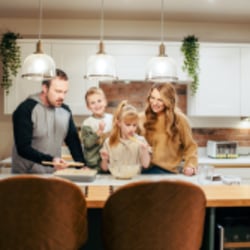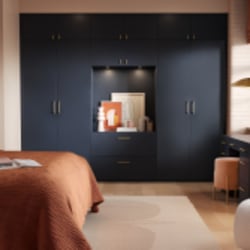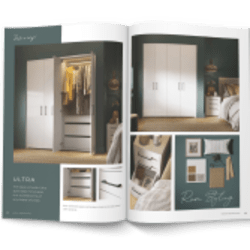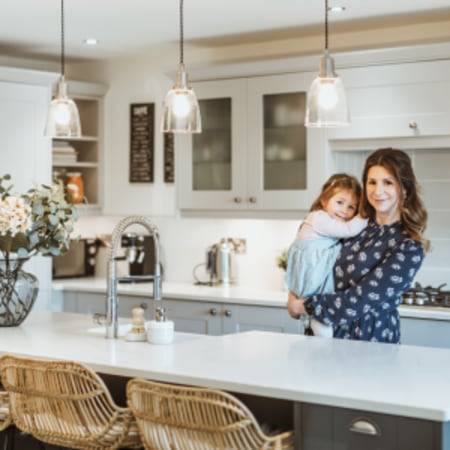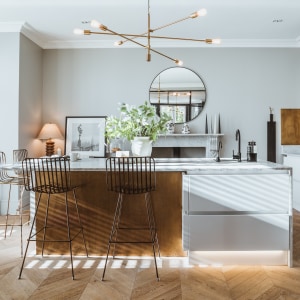Fitted Kitchens: Buying Guide
Fitted Kitchens
The kitchen really is the heart of the home, so it’s important to create a welcoming and homely environment where you love to spend time cooking, socialising, and eating with friends and family. But, with so many different colours and designs to choose from, it can be difficult to know exactly what you want.
That’s where we’re here to help. The best fitted kitchens are designed according to a consistent style, with all cabinets, appliances, and worktops following the same design scheme. Often, bulky appliances will even be integrated or hidden to give a clean finish throughout. This guide outlines all you need to know to buy a fitted kitchen, including the factors you need to consider, the styles and finishes on offer, and how to pick the perfect layout.
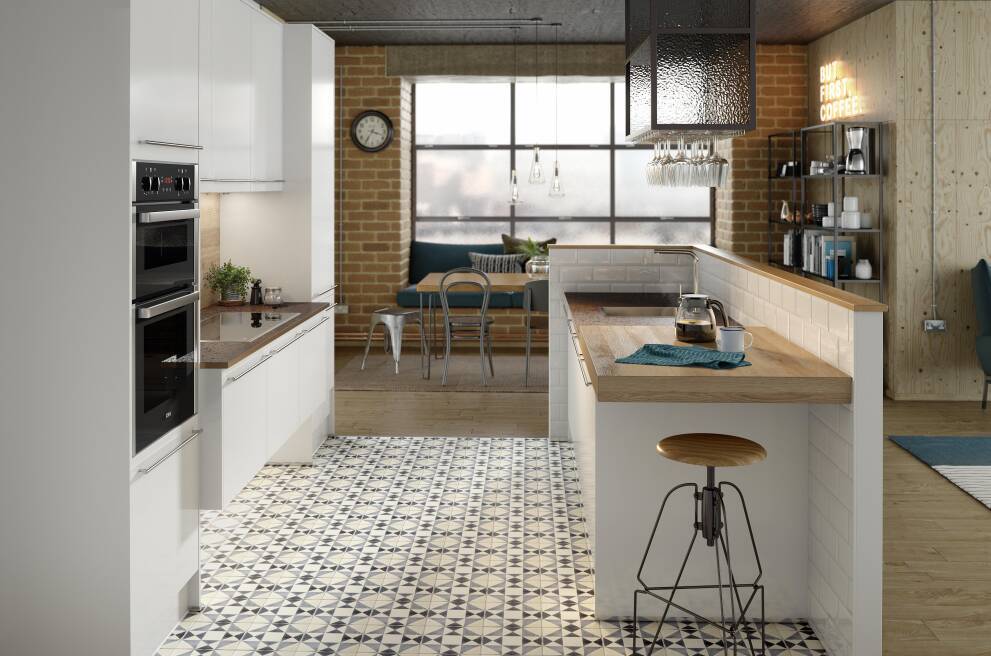
Before you start
Before you’re able to start choosing your dream fitted kitchen, you should spend time working out your available space and budget. This is to ensure your plans don’t exceed capacity, on both counts.
Space
Fitted kitchens are sleek and stylish, and each fixture is installed with purpose and precision to offer a flush and consistent finish that complements your design scheme.
With this in mind, it’s important to accurately measure your available space, from floorplan to wall size. This will allow you to map out your potential layout and determine how much flooring you’ll need, figure out whether you’ll require tall tower units to maximise room, and plan where to position your fridge, freezer, cooker and dishwasher for practical use.
Measuring your entire kitchen can cause confusion, if you’ve never done it before, so we offer a handy home measurement service to take the weight off your shoulders.
Budget
It’s important to take your budget into account throughout the planning stage, as it will likely guide many of your decisions when you buy fitted kitchen features. Think about how much you can reasonably afford to spend on fixtures and cabinetry, flooring, and appliances, as well as areas you might be able to save. For instance, you might want authentic oak flooring, but decide that laminate or vinyl will offer the same style at a cheaper rate.
The cost of a fully fitted kitchen varies, depending on your layout and the complexity of work required, your choice of materials, and the colour palette you require to achieve the look you want. However, at Wren, we don’t believe you should ever have to compromise on style, even if you dream kitchen at first seems a little over budget.
To make a gorgeous new fitted kitchen accessible for everything, we offer three categories that increase in cost as they become more bespoke. Our range starts with the Vogue flat pack collection, which makes even the chicest kitchens an affordable luxury, followed by our factory-built Infinity range and exclusive Infinity Plus kitchens that allow you to combine almost any colours, materials, and finishes you can think of.
Different styles of kitchens
We all have our own sense of style, especially when choosing features for the home and kitchen. Take inspiration from the three most common design schemes, traditional, modern, and shaker, when coming up with your own fitted kitchen ideas.
Traditional
Traditional fitted kitchens offer classic charm, combining homely features with a warm and welcoming colour palette, and placing a strong emphasis on natural tones and materials. Think rugged wooden beams and cabinetry, rich stone worktops, and gorgeously patterned backsplashes. Or for something bursting with character; rustic taps and copper lighting work a treat when styled as part of a vintage theme.
But that doesn’t mean that a traditional kitchen can’t keep up with the times; consider integrated appliances hidden behind stylish panels that ensure your bold contemporary tech doesn’t disrupt your classic design scheme.
Modern
There’s no set blueprint for designing the perfect modern kitchen, with personal taste the most important factor to consider in the planning process. However, as a general rule, this style often adheres to simplicity, sleek minimalism, and clean lines.
A particularly great benefit of this modern design scheme is that, as smart kitchens become increasingly prominent, the simple layout will complement your evolving space. But don’t feel like you need to think futuristically at every turn; instead, take the modern features you enjoy and blend with your own character.
Shaker
A shaker-style space is centred around practicality, making it the fitted kitchen of choice for anyone who prioritises a functional layout, accessible appliances, and gorgeous simplicity. Timelessly clean, a shaker kitchen promotes a light and welcoming feel and effortless maintenance.
It’s this versatility that offers you so many avenues to follow when styling your space. Whether you favour a matt or glossy finish, you’ll find a shaker kitchen suits a broad array of features, colours, and materials.
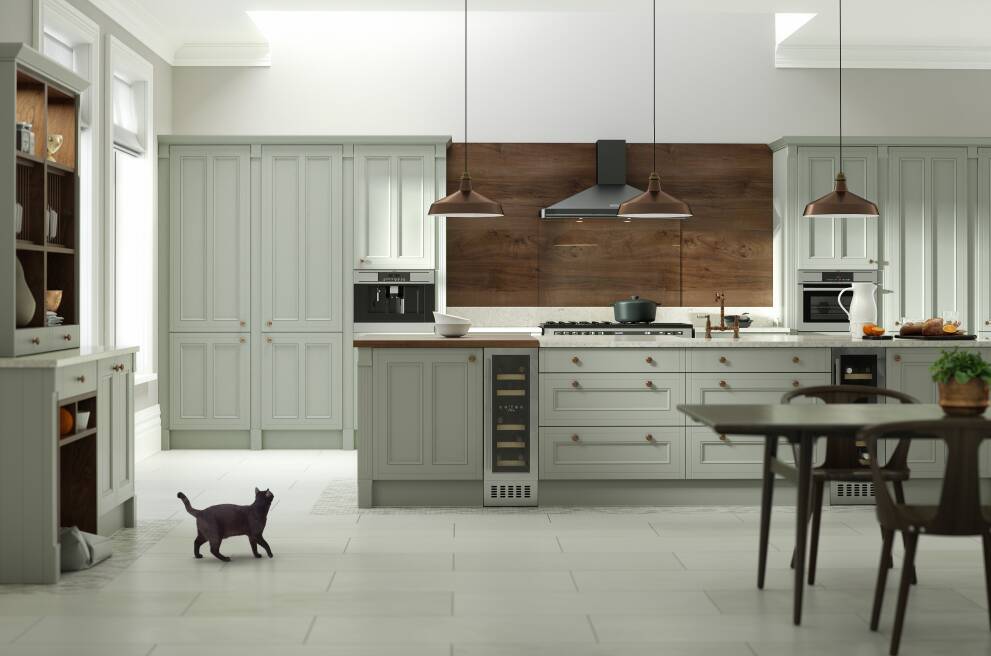
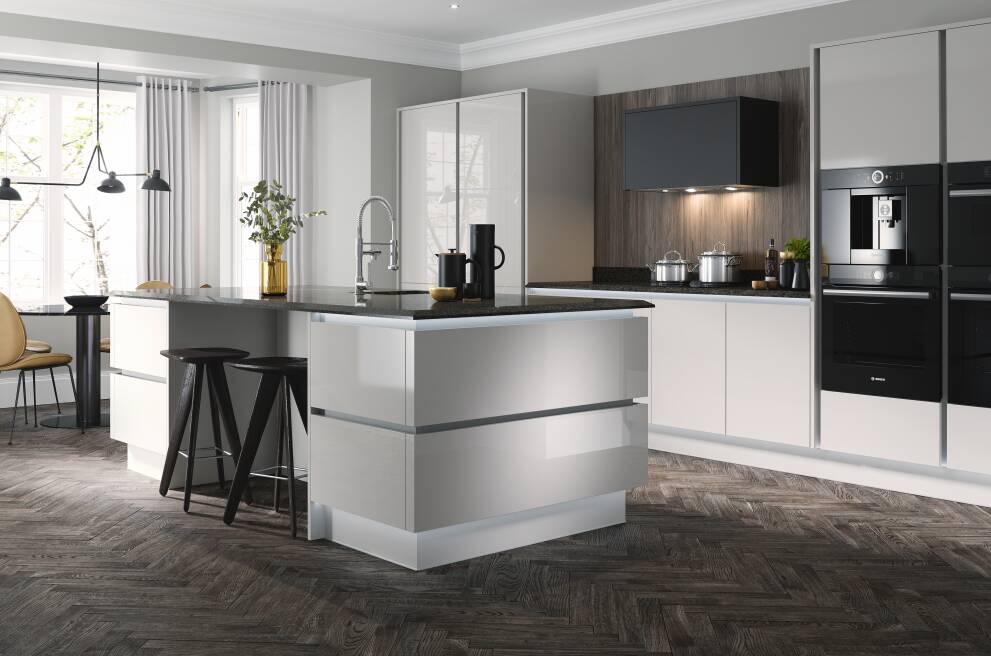

Types of cabinet hardware
When deliberating fitted kitchen designs, it’s important to consider your cabinet hardware, which, while subtle, can really make or break your look.

Pulls
Pull handles are named literally and serve the exact purpose they suggest; they are used via a straightforward pulling motion when you want to open your kitchen cabinets and drawers. They’re particularly practical for heavy or tall doors that require a little leverage, and make it easier to open drawers, which don’t naturally support a twisting action.
Aesthetically, choose from bar, cup, and arch designs, available in an array of versatile shapes, sizes, and materials, to find the style that perfectly suits your classic or contemporary finish. And it’s good news if you’re not particularly DIY savvy, as installation simply involves screwing your handle directly into your cabinet’s front panel.

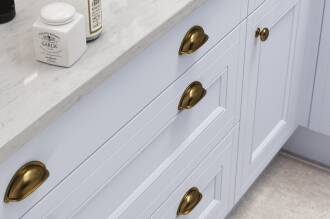
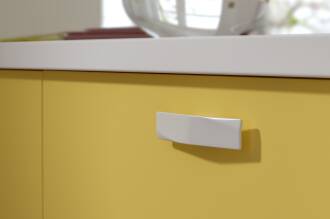
Knobs
Available in a selection of shapes and sizes, from round and mushroom to square and bar, knob handles inject character and style. Often found in traditional properties, the bulbous design offers bold decoration to your kitchen.
Another benefit of knob handles is their efficiency in ensuring your cabinets remain closed, requiring a twist to unlock, which is great for families with young and inquisitive children.
One drawback of knob handles, though, is that they’re not particularly practical additions to drawers or heavy cabinetry. Instead, consider the ways you can combine attractive knobs with elegant pull handles throughout your space to get the best of both.
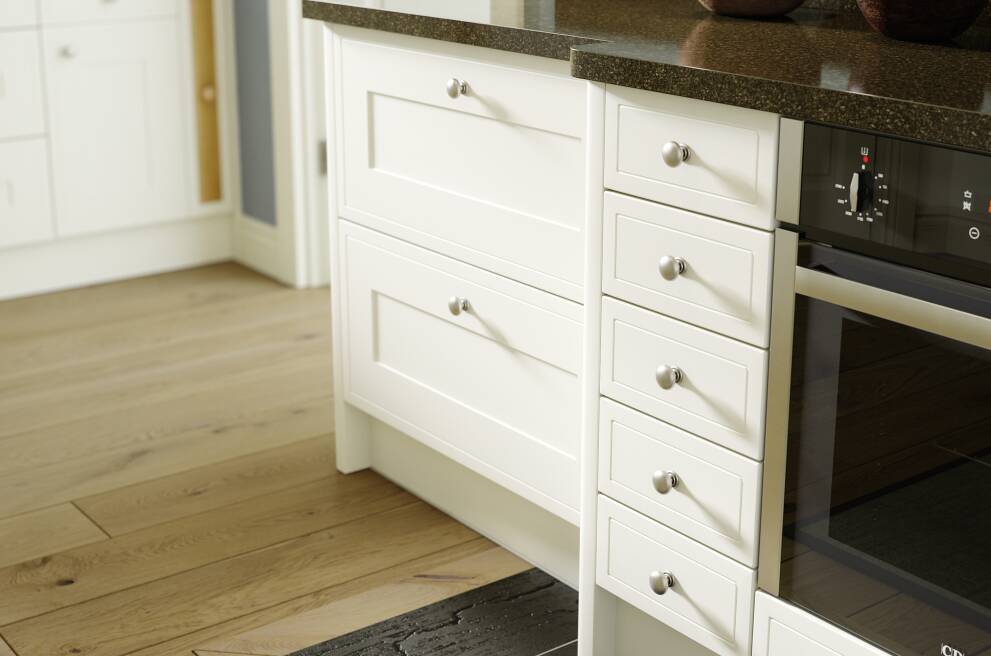
Cremone bolts
Cremone bolts offer additional security and peace of mind that your kitchen cabinets are completely closed with no chance of swinging open. Simple but efficient, cremone bolts are essentially a little rod that is effortless pushed into a casing fixed to the top or bottom of your frame.
Stylistically, cremone bolts are often found in traditional kitchens that are designed around vintage features and rustic accents, but metallic bolts can also be incorporated into a contemporary kitchen, to offer bold contrast; this is especially impactful in a larger space that requires a touch of personality.
Kitchen cabinet hinges
They might not be the most glamourous of features, but finding the right cabinet hinge can add the finishing touch to your fitted kitchen. We’ve gone through the most common hinges, and offers guidance around why each might work well for you.
Butt
Butt hinges are common in vintage or traditional-style homes, intentionally exposed to offer rustic charm. Made of two connected plates joined by a barrel that runs down the centre, one side is screwed into your frame and the other into your door, for an easy swing. Their basic design means installation is as straightforward as it goes. But be conscious of how heavy your cabinet door is, as you might require two or even three hinges to support the weight.
Flush
A flush hinge is styled similarly to a butt hinge, but has a thinner profile that makes it the ideal alternative if your cabinets offer a little less room for bulky statement pieces. They’re installed exactly the same way as butt hinges, however, with one plate simply screwed into the frame and the other to the door. Because of their slight, flush hinges can’t carry too much weight so should be reserved for lighter cabinets.
Concealed
As opposed to butt hinges, which are purposefully visible, concealed hinges are much more subtle. This makes them a popular choice in contemporary kitchens that are styled around clean lines and smooth surfaces. Installed on the inside of your door, the hinge will be completely hidden when the door is closed. Rather than being connected by a barrel running down the middle of the two plates, a concealed hinge, instead, operates with a flat mechanism that sits flush with your cabinet door.
Wrap-around
A wrap-around hinge is similar in style to a concealed hinge, but is more robust and offers a little extra support, making them the ideal pick for heavy cupboard doors or weightier floor-to-ceiling cabinets. Ideal in a contemporary or shaker kitchen, you’ll enjoy practical functionality without disrupting your minimalist design scheme.
Overlay
Overlay hinges allow your cupboard door to completely cover your unit frame when closed, complementing crisp lines and minimalist features. Often, as a result, you’ll find overlay hinges to be concealed and discreet in, which makes them the ideal addition to any contemporary or shaker design scheme.
Offset
Offset hinges are a practical solution if you need to move your cabinet door a little from the frame, for additional clearance and storage room. Robust and sturdy in design, offset hinges can carry heavier doors than most others. Designed to allow you to repurpose your existing door and frame, instead of replacing the full unit, they’re an incredibly cost-effective solution.
Soft-closing
Self-closing cabinet hinges are built with practicality and ease in mind. The metal frame encases little springs that slowly pull your cabinets completely shut after use, ensuring you’ll never have to endure half-open drawers and doors again. Often, you’ll find that your self-closing hinge is also concealed, which makes it a great choice in contemporary kitchens where sleek design is encouraged. But elegance isn’t the only benefit to self-closing hinges; their soft-close functionality means they don’t slam shut, making them the perfect pick for families with young children who might be susceptible to trapped fingers!
Other things to consider for your fitted kitchen
Before you can order your fitted kitchen, you’ll need to make a few final considerations: your colour combinations, the shape of your units, and the finish of your worktops.
Colour
Your colour choices are crucial when adding the finishing touches to your fitted kitchen; certain combinations can really elevate your style, while some can act against you. As a rule of thumb, however, monochromatic blacks, whites, and greys are often found in contemporary kitchens that favour sleek simplicity, while natural creams, greens, and autumnal browns work well alongside wooden features in a traditional space.
If you’re looking to inject personality, timeless two-tone against a crisp white backdrop is always a strong option, no matter the design scheme, whether you prefer popping pastels or soft pinks and blues.
Kitchen shapes
When styling your dream kitchen, consider the different shapes and designs available, and how each might complement your available space. For instance, smaller fitted kitchens might better-suit a one-wall or galley layout that fits tall appliances flush with integrated storage and cabinetry.
Alternatively, a larger kitchen can sometimes feel a little lifeless, so perhaps breathe energy into your space with a practical U-shape design that offers flexible workspace, L-shaped countertops that complement an open-plan layout, or even a handy island that can double up as a food preparation station and family eating area.
Worktops
Once you’re happy with your kitchen colour scheme and layout choices, it’s time to consider the finish of your worktops and surfaces. This is just as important a decision as any other stylistic step, as the finish you opt for can completely enhance your kitchen look and feel. When comparing fitted kitchen designs, you’ll have three options to choose: matt, glossy, and wood.
A glossy kitchen is often associated with a contemporary layout, and effortlessly complements a handleless design centred around smoothness. Meanwhile, you’ll likely find a matt finish in a traditional or shaker layout, for a timeless look that’s bold and chic. In a larger kitchen that can afford contrasting features, even consider incorporating the two and enjoy the combined benefits of sleek elegance and understated minimalism.
If neither matt nor glossy worktops suit your style, perhaps implement a wooden finish. This helps to inject warm ambience, and works effortlessly alongside a traditional design scheme where natural materials are the focus.
Decided on your style, features, and finish? Book an appointment with our expert designers to make your dream kitchen a reality, or visit a showroom to experience our complete collection of fully fitted kitchens in person.

